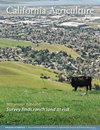农业管理含水层补给——需考虑的水质因素
IF 1.1
4区 农林科学
Q2 AGRICULTURE, MULTIDISCIPLINARY
引用次数: 17
摘要
加州农业的恢复力和生产力受到地下水超采、含水层水质下降、地面沉降对基础设施的破坏增加以及地下水储存能力不可逆转的下降的威胁。在冬季故意淹没农田——这种做法被称为农业管理含水层补给(AgMAR)——有助于抵消透支。然而,AgMAR可能会加剧硝酸盐/盐的浸出和高危含水层的污染,这仍然是一个令人严重关切的问题。为了量化AgMAR污染地下水的风险,我们在12个杏仁园、加工番茄田和葡萄酒葡萄园的低渗透和高渗透土壤上采集了30英尺长的土壤芯,测量了硝酸盐和总溶解固体浓度,并计算了储存的硝酸盐-N。渗透性土壤上的葡萄酒葡萄园的硝酸盐浸出风险最小。然而,如果建立专门的补给点并使用清洁的地表水进行补给,则可以利用杏仁园和番茄田进行AgMAR。历史土地利用、当前氮管理和土壤渗透性等级是实施AgMAR之前需要考虑的主要因素。本文章由计算机程序翻译,如有差异,请以英文原文为准。
Agricultural managed aquifer recharge — water quality factors to consider
The resilience and productivity of California's agriculture is threatened by groundwater overdraft, reduction in aquifer water quality, increased land subsidence damage to infrastructure and an irreversible reduction in groundwater storage capacity. Intentionally flooding agricultural fields during winter — a practice referred to as agricultural managed aquifer recharge (AgMAR) — can help counteract overdraft. However, the potential for AgMAR to exacerbate nitrate/salt leaching and contamination of at-risk aquifers remains a critical concern. To quantify the risk of groundwater contamination with AgMAR, we took 30-foot-long soil cores in 12 almond orchards, processing tomato fields and wine grape vineyards on low- and high-permeability soils, measured nitrate and total dissolved solids concentrations and calculated stored nitrate-N. Wine grape vineyards on permeable soils had the least nitrate leaching risk observed. However, almond orchards and tomato fields could be leveraged for AgMAR if dedicated recharge sites were established and clean surface water used for recharge. Historical land use, current nitrogen management and soil permeability class are the main factors to consider before implementing AgMAR.
求助全文
通过发布文献求助,成功后即可免费获取论文全文。
去求助
来源期刊

California Agriculture
农林科学-农业综合
CiteScore
2.40
自引率
7.70%
发文量
17
审稿时长
>12 weeks
期刊介绍:
Information not localized
 求助内容:
求助内容: 应助结果提醒方式:
应助结果提醒方式:


